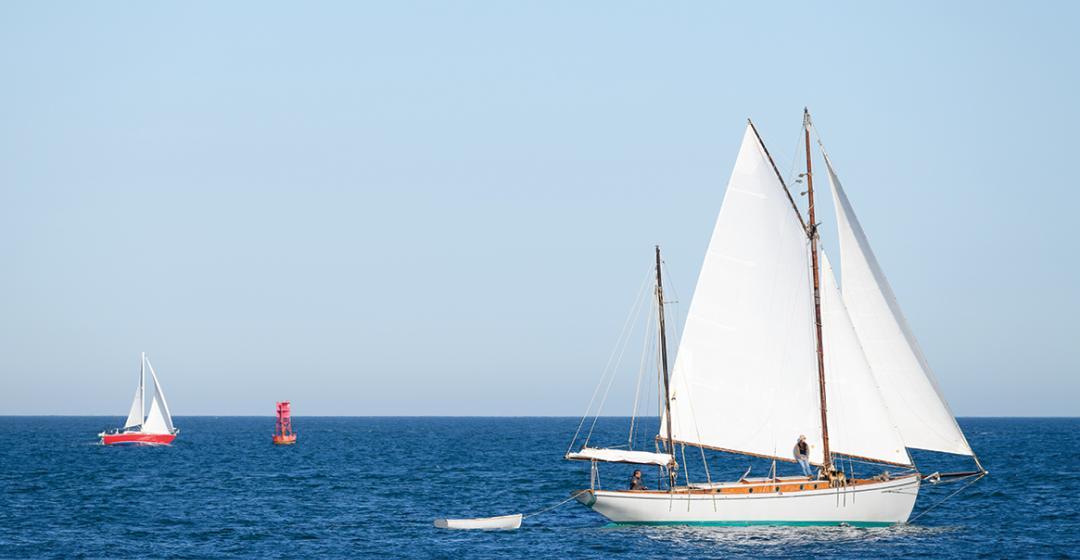Abbie and Lyle Zell met in the summer of 2011 on the edge of Vineyard Haven Harbor. At the time, both were part of the working waterfront: Lyle worked at his father’s old-timey boatyard – Gannon & Benjamin Marine Railway – and Abbie crewed on The Black Dog Tall Ship schooner Alabama, which was docked next door. Six years into their relationship, the couple was offered a gift by a local sailor named Tom Grew: his old boat, a twenty-ton ketch called Ayuthia.
Grew never really wanted to let Ayuthia go. But she has so many broad surfaces to maintain – gallons of paint, varnish, caulking, and oil are needed every season – that as he got older, she became too much for him to manage. He had bought Ayuthia in the early 1980s, but he sailed into Vineyard Haven for the first time in 1972 aboard a smaller ketch. Grew still lives in Vineyard Haven, where he is a fixture on the harborfront. He didn’t want to see Ayuthia leave.
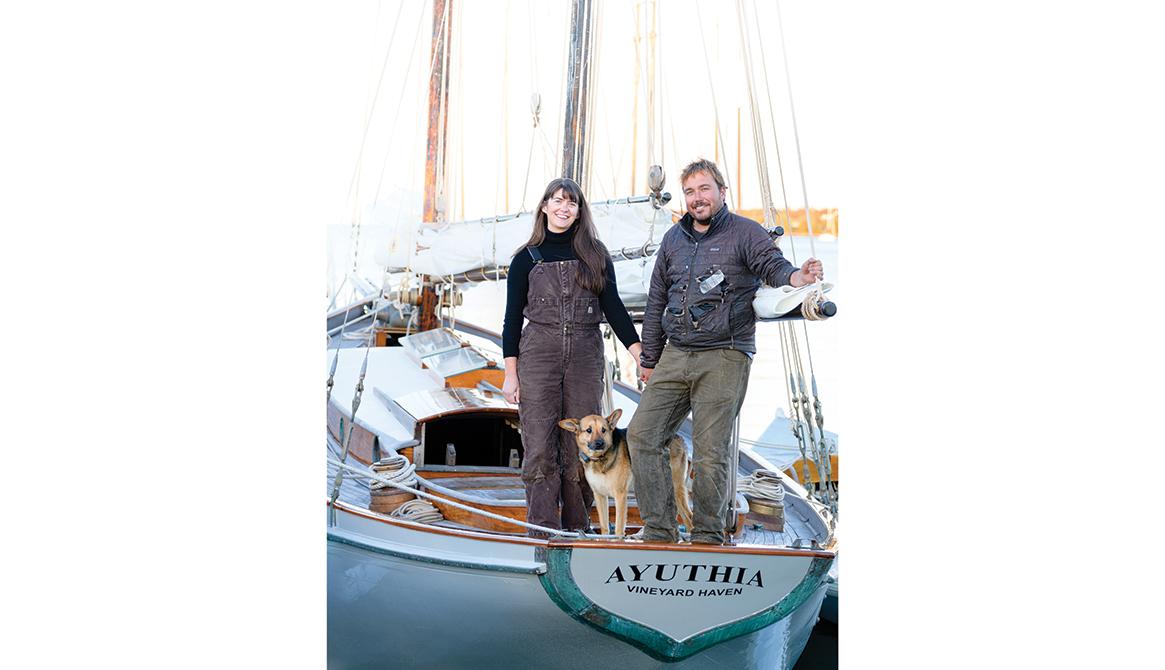
Grew chose Lyle and Abbie as Ayuthia’s next owners because Lyle is one of a few people on the Island who would be able to address the boat’s deficiencies with his own hands. Lyle had grown up in the shop at Gannon & Benjamin, working alongside his father, Ross Gannon, who cofounded the business in 1980. Today, Lyle is a builder and manager at the company where he repairs, maintains, and operates all the yard’s heavy machinery. He is an excellent carpenter and welder and is often the first person people consult when they have questions about rigging. While Abbie now works at South Mountain Company in West Tisbury, where she is the communications coordinator, she still shares a love of sailing with her husband and friends.
When Ayuthia came into their possession in 2017, Lyle noted the work that needed to be done. “You couldn’t see where any of the deck leaks were because there was some kind of asbestos cement-board insulation covering the overhead,” he said. “It was always damp. The paint was peeling off in flakes. It left a dust.”
Ayuthia’s story began in Bangkok in 1936 when Englishman Maurice Griffiths designed her with a double-gaff ketch rig for Alfred Harris. A traditional English ketch has two masts holding two parallelogram-shaped sails with sticks at their tops, nearly as thick as their booms. The larger of the two masts is in the front. It was odd for an English boat to have a centerboard then, an American contraption that allows a boat with shallow draft to sail like a boat with a larger underwater profile, but that is Ayuthia.
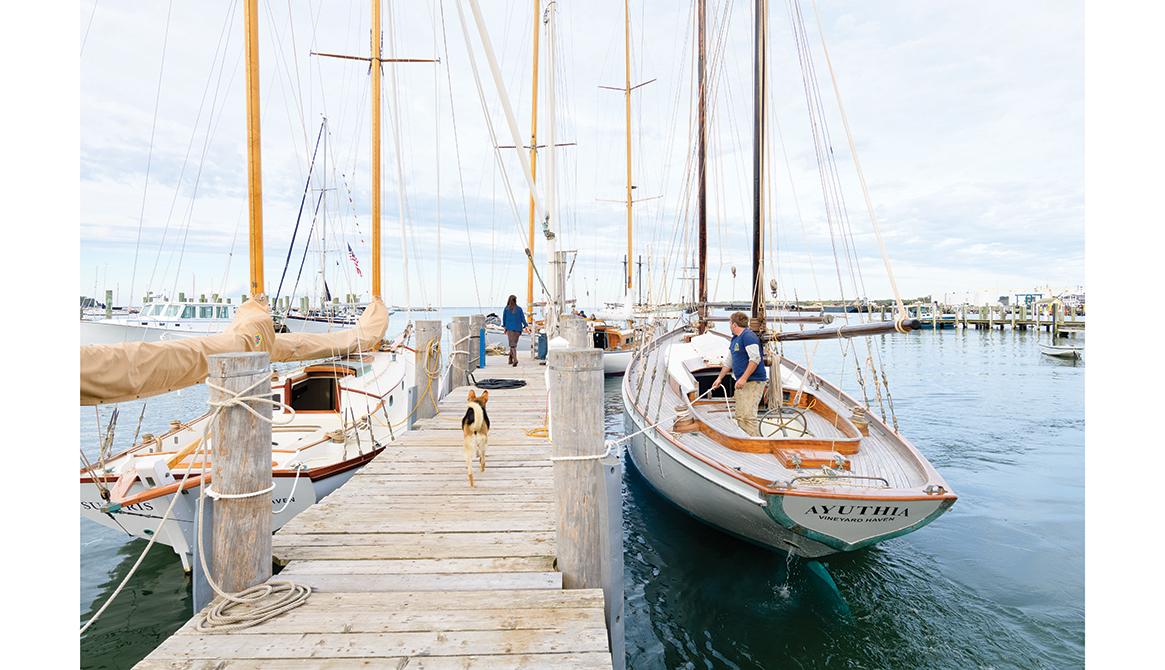
In Siam (now Thailand) at the time, mostly Chinese carpenters worked in the boatyards. They used the most noble of all hardwoods, fragrant brown teak, to make up the planks that cover the hull, the cabin houses, the decks, and to build the interior. Teak is fine grained, strong and oily in a combination that makes it easy to mark and cut and nearly impervious to degradation when left in the weather. Bare teak is soft to the touch, like suede, then grips the bottom of your foot like leather when you walk on it.
The people that built Ayuthia did not use electric tools. Boats were sealed with a preservative called chung, which was collected as a resin from Eucommia ulmoides, a species of small trees. When heated and reduced with oil, in different thicknesses, it could be used to seal between the wooden parts: everywhere from in between the great timbers that make up Ayuthia’s backbone to the joinery that held together the old deck.
The boat still smells like chung down below: a mixture of tea and sandalwood. “It’s a nice smell,” Abbie said.
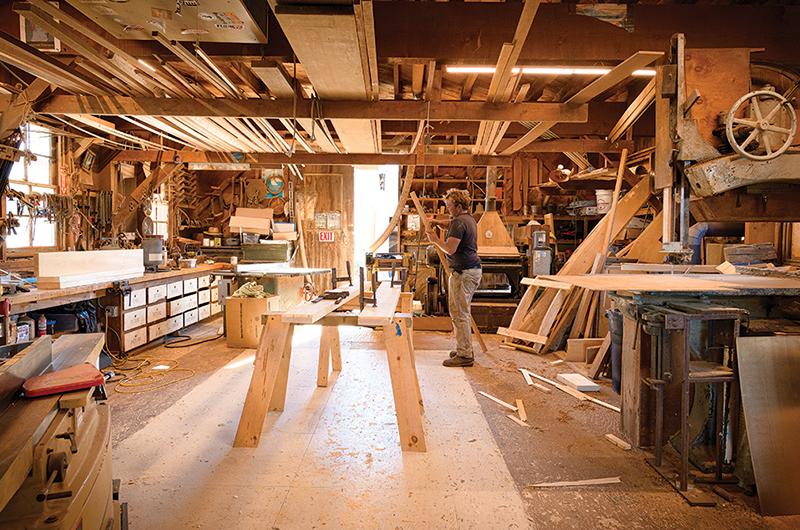
After Ayuthia was built, the boat went to England where she survived World War II in the countryside. It was her owner’s peculiar passion for exploring the rivers around Falmouth and Helford that led to the extravagantly shallow design that enabled her to hide in the quiet mud while entire English harbors were destroyed by Nazi bombs.
After World War II, Ayuthia came across the Atlantic on a ship and ended up in the Chesapeake. In 1958 Captain Robert Douglas, before he built Shenandoah or The Black Dog franchise, purchased Ayuthia after he got out of the Air Force. He sailed her to the Bahamas once, but he mostly sailed around New England before bringing Ayuthia to the Vineyard.
One of the first things Douglas did when he owned the boat was to hire someone to tear out the centerboard – and the not-so-watertight centerboard trunk that surrounded it – because it leaked terribly. (A centerboard and trunk were reinstalled in the 1980s, but nobody would admit to doing the work. It has been a source of frustration to many Island sailors that it gets stuck when it’s drawn up in the trunk.)
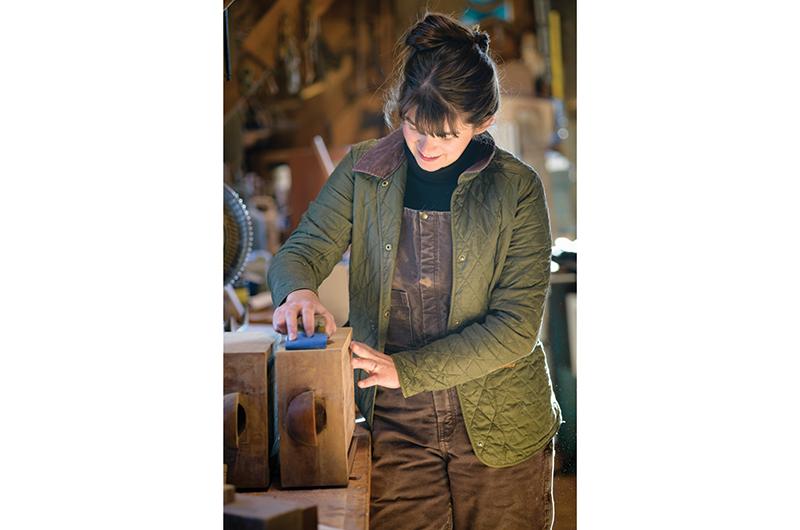
After twelve years, Douglas sold Ayuthia to John Hastings, who lived on the Cape. He owned her for ten years before selling the ketch to Islander Mike Jampel, who rarely sailed it. When Jampel tried to give Ayuthia back to Douglas, he encouraged him to donate the boat to the Vineyard Montessori School. Grew bought Ayuthia from the school in an auction in 1982.
Into the early 2000s, Grew lived and worked on Ayuthia in Vineyard Haven, where he had a booming charter business. “One hundred and eighty trips,” he said. “June first to Columbus Day. That was the goal. Some years I did better.”
In winter, he took the boat to Man-O-War Cay in the Bahamas, where he could afford to haul it out for maintenance.
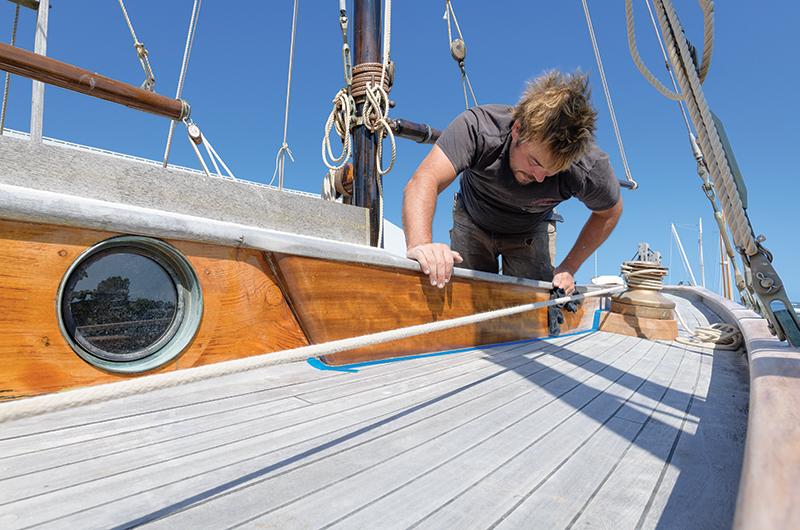
The part of Ayuthia’s legend that’s most repeated around the Vineyard Haven waterfront is the story of how one of Grew’s deliveries dramatically ended. In 1995, while trying to make landfall at Man-O-War Cay, venturing into the harbor in the dark, Ayuthia missed the channel through the reef. They were sailing directly downwind. The boat landed on the coral with enough force to split the cabin house exactly in half, which it indeed did, in a line around all the portholes.
Successive waves lifted the boat up and smashed it down again. In three great hops, the force of the ocean swell carried Ayuthia over the reef. On the calm side of the reef, in twenty-five feet of water, she sank. Grew took full responsibility for the disaster. “I was arrogant. I trusted the GPS. I should have been more careful lining up radio towers,” he said.
A Bahamian crew raised the boat, hauled it out, and put temporary plywood patches on the hull by the end of the next day. Grew had the boat towed to Florida then shipped back to Vineyard Haven where she was repaired on the railway at Gannon & Benjamin by Andy Lyons.

Lyons replaced the rudder, removed and rebuilt the entire split cabin house, and repaired fifteen busted planks.
“The frames are three-inch square. They’re sawn from some really hard Asian wood,” Lyons said. “It’s really rot resistant and really tough. None of the frames were broken. And that teak planking, it is so fine-grained that where it landed on the reef the plank was broken, but the next frame bay over, the plank would be perfect. There were no spiderwebbing fractures anywhere.”
For twenty tons of boat to land on a coral reef three times and come away with all her structure intact is surprising.
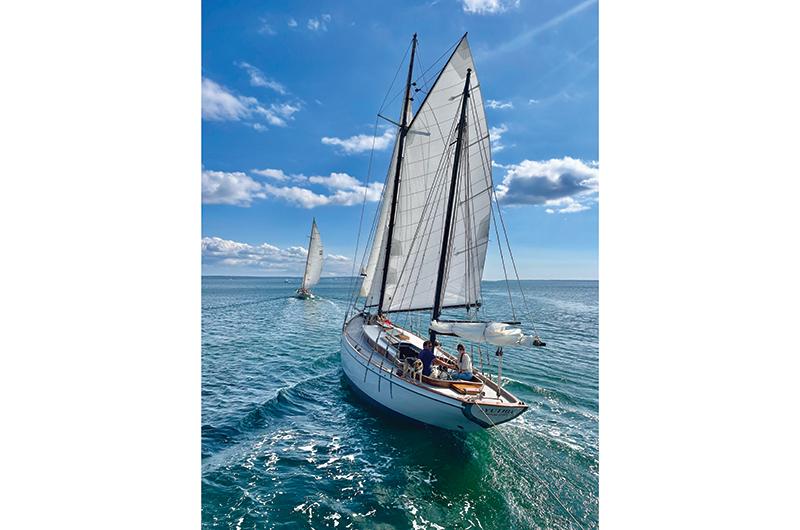
“Part of our decision to take this project on is really the quality of the construction of the boat,” Abbie said. “We know how special it is.”
For Lyle and Abbie, a major step after they took ownership of Ayuthia was to remove her leaky cabin top and install a new one. In 2020, over a couple weeks in the summer, with very limited help from anybody, Lyle did just that. “Rain came in like through a sieve,” he remembered. He installed the sliding hatch in a new place to make it safer and easier to use. Originally you had to leave the cockpit to reach the old entrance to the cabin, which was down a steep ladder on the side of the cabin house. The new cabin top also left a dry spot in the middle of the boat to leave tools.
The next year, when Ayuthia was hauled out again and Lyle had taken the deck off, nearly every boatbuilder on the Island climbed the stairs to the second story of the shrink-wrapped house he had built in the parking lot in front of the Gannon & Benjamin schooner shed. They marveled at the hand-cut joints that had been hidden underneath the planks of teak decking for eighty-five years. On top of the frames, in the corners under the deck, were sugar packets that must have floated up when she sank behind the reef in the Bahamas.
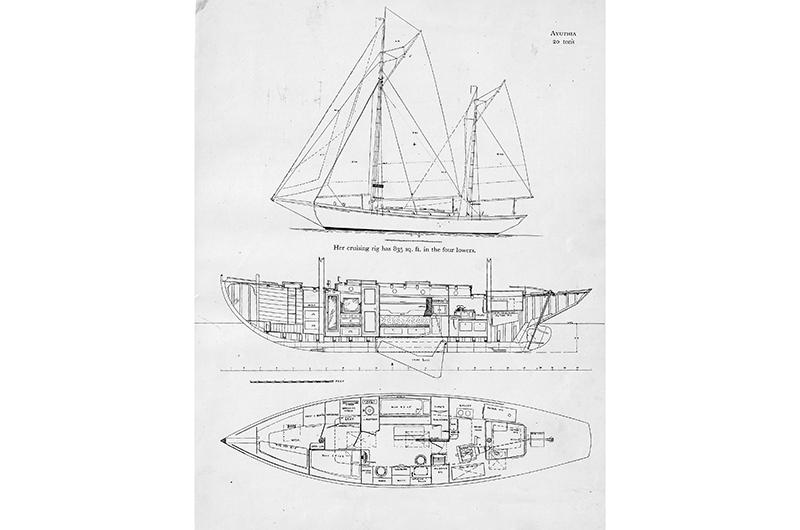
When Lyle rebuilt the deck – a three-year process – he didn’t just fit and glue sheets of marine plywood over the repaired framing. He put an overlay of iroko boards in the style of the expired teak deck on top of it. He raised the cabin and the bulwarks on carved teak grubs so the seams they made with the deck would never be in places that collected and held water. Most of the hardware he custom built matches the shapes and the bronze of the original kit. Lyle even welded a new piece of hardware to hold the anchor at the bow in his own design. “I just want it to work,” he said.
Captain Douglas came by to have a look at the boat when it was at the dock after it was relaunched in the fall of 2023. He had brought the boat to Vineyard Haven sixty-five years before. “I never saw it looking that good. It’s amazing,” he said. Douglas also approved of the way Lyle redesigned the cockpit and companionway. “You couldn’t sit in it before,” Douglas said.
Last fall, after a few years of hard work, Lyle and Abbie were able to do some cruising aboard Ayuthia around the Elizabeth Islands for a couple of days. “We were the only boat anchored in Cuttyhunk Harbor,” Abbie said. “It was glorious.”
“It’s been really fun to use the boat,” Lyle echoed.
The night after they anchored in Cuttyhunk Harbor, Ayuthia and her crew sailed into Tarpaulin Cove on Naushon Island where they joined the Salami Cup – a Vineyard Haven Harbor tradition of a community sailing race that isn’t actually a race. After the finish, everybody lights a big fire on the beach and prizes are given for doing things with boats. For the extent and the quality of the restoration they did, Lyle and Abbie were unanimously awarded the Salami Cup, and a length of cured smoked meat, which they shared with everybody.
“I know, for me, this community is a really big reason I enjoy doing the work,” Abbie said.
Grew gave Ayuthia to Lyle and Abbie in the hopes that the boat would have another life. It might get a few.

